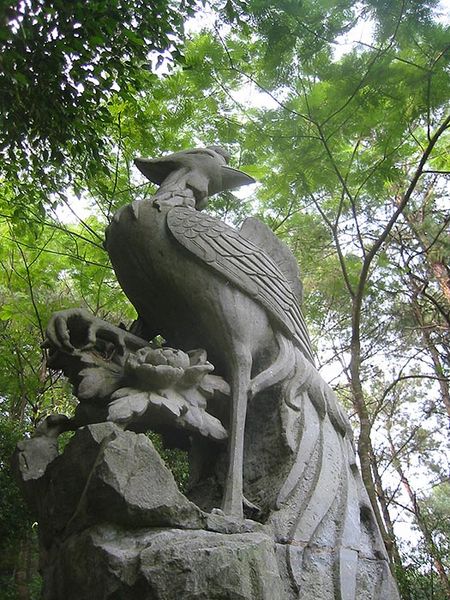
August 14, 2007

Monday afternoon, August 13, 2007, a bridge fell in Fenghuang, China. Early reports are of over 30 killed, 46 missing, and 86 saved. (Update, August 15: The death toll is 36 with 23 missing.)
You must look closely at the photographs above and below to see the humans and their recovery equipment; the bridge collapse was massive. Our sympathies to the families and victims.

Unknown to the mainstream English-speaking journalists who are reporting this breaking news, you will want to know that the name of the Chinese location is heavily tied into myth, legend, and folklore concerning a special cryptid bird. Should we turn away from this information or learn something from this event? While many routinely talk about the bird to be highlighted, as the Chinese Phoenix, something more cryptozoological exists behind the “Fenghuang.”
The recent Silver Bridge and I-35W bridge discussions have been of Mothman, but this event has something to teach us about Fenghuang beneath it.
At the Chinese city with the name Fenghuang, witnesses described hearing a rumble and seeing stones fall from the structure after construction workers removed scaffolding from the 140-foot-high, 880-foot-long (42-meter-high, 268-meter-long ) vehicle and pedestrian bridge across the Tuo River in the southern town of Fenghuang.
Fenghuang is an ancient trading town surrounded by lush mountains and rice paddies, and known for the colorful dress of its Miao, or Hmong, ethnic natives and its traditional stilt houses along the Tuo. In recent years, Fenghuang has aggressively promoted itself as a tourist destination.
Incredibly, digging behind the name Fenghuang reveals some amazing lore.
The Fenghuang.
The Fenghuang are mythological Chinese birds that reign over all other birds. The Fenghuang is also called the “August Rooster,” and thus it is intriguing this bridge collapsed in August.
The taloned, long-necked, long-legged, tall grasping Fenghuang (see images on this page) have appeared in China for over 7,000 years, back to the days of the ancient eastern tribes. The Fenghuang’s snake-like neck may be a folk memory of the Asian Ostrich (Struthio asiaticus), which was common in prehistoric China but became extinct only a few thousand years ago, at the end of the Pleistocene.
This bird was known to the early Asian humans as evidenced by numerous archaeological finds, including decorated pottery with what appear to be painted ostriches, and bones discovered at early campsites. As such, the Fenghuang certainly deserves a page in cryptozoology.
Interestingly, in terms of the zoological basis of West Virginia’s Mothman, one candidate is the four feet tall extinct Cuban owl that has long legs similar to the Fenghuang’s.

The Fenghuang.
China’s Fenghuang usually are given positive connotations, and are said to appear in peaceful and prosperous times but hide when trouble is near.
Fenghuang is the county and town in western Hunan province of China, where the bridge collapse occurred, and its name is written with the same Chinese characters as the mythological bird.

The Fenghuang collapse is among the worst in recent memory. In January 1999, 40 people died when a pedestrian bridge spanning the Qi River in southwestern China’s Sichuan province collapsed just three years after it was built.
About Loren Coleman
Loren Coleman is one of the world’s leading cryptozoologists, some say “the” leading living cryptozoologist. Certainly, he is acknowledged as the current living American researcher and writer who has most popularized cryptozoology in the late 20th and early 21st centuries.
Starting his fieldwork and investigations in 1960, after traveling and trekking extensively in pursuit of cryptozoological mysteries, Coleman began writing to share his experiences in 1969. An honorary member of Ivan T. Sanderson’s Society for the Investigation of the Unexplained in the 1970s, Coleman has been bestowed with similar honorary memberships of the North Idaho College Cryptozoology Club in 1983, and in subsequent years, that of the British Columbia Scientific Cryptozoology Club, CryptoSafari International, and other international organizations. He was also a Life Member and Benefactor of the International Society of Cryptozoology (now-defunct).
Loren Coleman’s daily blog, as a member of the Cryptomundo Team, served as an ongoing avenue of communication for the ever-growing body of cryptozoo news from 2005 through 2013. He returned as an infrequent contributor beginning Halloween week of 2015.
Coleman is the founder in 2003, and current director of the International Cryptozoology Museum in Portland, Maine.
Filed under Breaking News, Cryptomundo Exclusive, Cryptotourism, CryptoZoo News, Cryptozoologists, Cryptozoology, Folklore, Media Appearances, Photos, Pop Culture, Thunderbirds